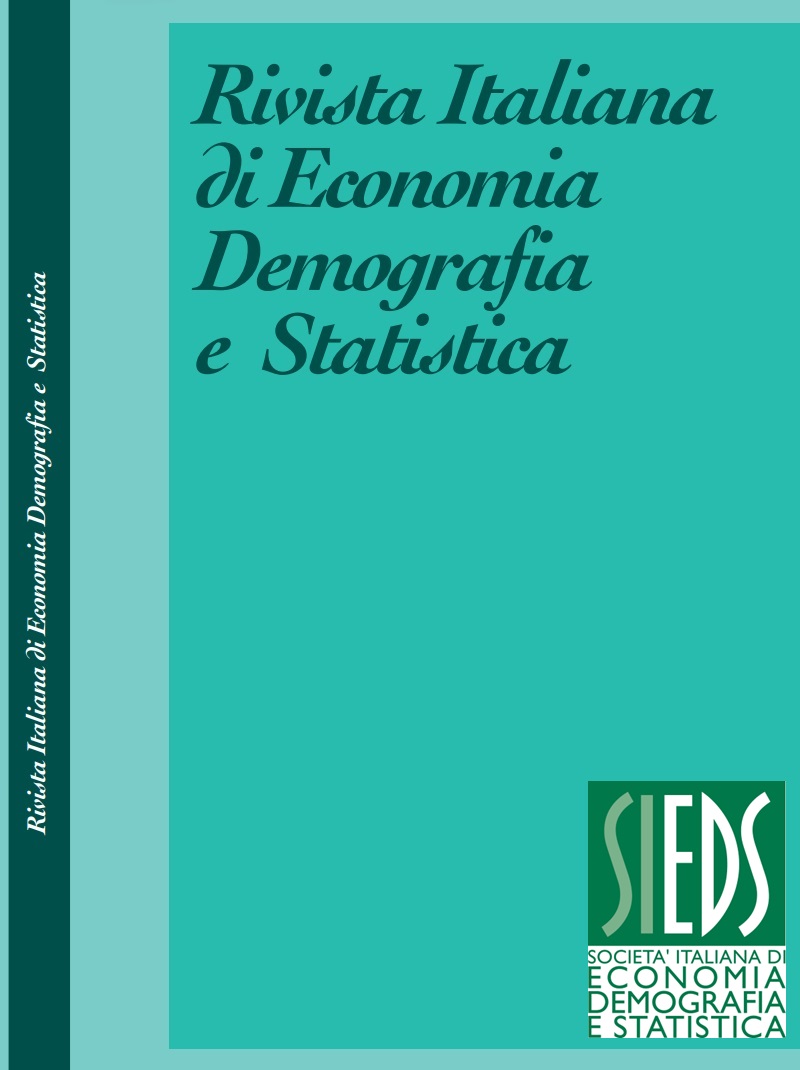Low fertility in context: the case of Italy
DOI:
https://doi.org/10.71014/sieds.v79i1.292Keywords:
fertility, inner areas, local areasAbstract
Numerous studies have shown that fertility behaviour in Italy, as elsewhere, strongly depends on subnational contextual factors. With this study we add to that literature investigating how group-specific fertility rates differ across fine-graded local areas’ characteristics. We utilize ISTAT micro-level vital registration records including all births registered in each Italian municipality for the year 2022 and information about parity and parents’ age to construct age- and parity- specific fertility rates. We match fertility data with the municipalities’ Inner Areas classification measuring the availability of (distance from) crucial services, and with other indicators of municipalities’ socioeconomic conditions that may influence fertility, such as per capita income, the share of high-tech workers and the availability of public childcare services. First, we present a descriptive illustration of the most recent group-specific fertility rates in different kinds of local areas in terms of population size, geographical location, and inner area class. Second, we utilize linear regression models to investigate the association between local areas’ characteristics and age- and parity-specific fertility rates.
References
BARCA, F., CARROSIO, G. 2020. Un modello di policy place-based: la Strategia Nazionale per le Aree Interne. In G. OSTI, JACHIA E. (Eds.) Un disegno di rinascita delle aree interne, Bologna: Il Mulino.
BENASSI, F., CARELLA, M. 2023. Modelling geographical variations in fertility and population density of Italian and foreign populations at the local scale: a spatial Durbin approach for Italy (2002–2018),Quality Quantity, Vol.57, No.3, pp. 2147-2164. DOI: https://doi.org/10.1007/s11135-022-01446-1
BENASSI, F., MUCCIARDI, M., CARELLA, M., NACCARATO, A., SALVATI, L. 2023. Spatial Segregation in Action? An Empirical Assessment of Population Concentration of Foreigners and Nationals in Italy, 2002–2018. International Migration Review. DOI: https://doi.org/10.1177/01979183231170808
BRAND, J. E., DAVIS, D. 2012. The impact of college education on fertility: Evidence for heterogeneous effects. Demography, Vol. 48, pp. 863–887. DOI: https://doi.org/10.1007/s13524-011-0034-3
BUELENS, M. 2021. Subnational spatial variations of fertility timing in Europe since 1990. Cybergeo: European Journal of Geography, No. 1000. DOI: https://doi.org/10.4000/cybergeo.37887
CAMPISI, N., KULU, H., MIKOLAI, J., KLÜSENER, S., MYRSKYLÄ, M. 2020. Spatial variation in fertility across Europe: Patterns and determinants. Population, Space and Place, Vol. 26, No. 4. DOI: https://doi.org/10.1002/psp.2308
COMOLLI, C. L. 2017. The fertility response to the Great Recession in Europe and the United States: Structural economic conditions and perceived economic uncertainty. Demographic research, Vol. 36, pp. 1549-1600. DOI: https://doi.org/10.4054/DemRes.2017.36.51
KOHLER, H. P., BILLARI, F. C., ORTEGA, J. A. 2002. The emergence of lowest‐low fertility in Europe during the 1990s. Population and development review,Vol. 28, No. 4, pp. 641-680. DOI: https://doi.org/10.1111/j.1728-4457.2002.00641.x
KULU, H., VIKAT, A., ANDERSSON, G. 2007. Settlement size and fertility in the Nordic countries. Population Studies, Vol. 61, No. 3, pp. 265–285. DOI: https://doi.org/10.1080/00324720701571749
MENCARINI, L., VIGNOLI, D. 2018. Genitori cercasi. L’Italia nella trappola demografica. Egea, Università Bocconi Editore.
NEYER, G. 2013. Welfare states, family policies, and fertility in Europe. In The demography of Europe. Dordrecht: Springer Netherlands. DOI: https://doi.org/10.1007/978-90-481-8978-6_3
REYNAUD, C., MICCOLI, S. 2018. Depopulation and the aging population: The relationship in Italian municipalities. Sustainability, Vol. 10, No.4, pp. 1004-1016. DOI: https://doi.org/10.3390/su10041004
RIEDERER, B., BUBER‐ENNSER, I. 2019. Regional context and realization of fertility intentions: The role of the urban context. Regional Studies, Vol. 53, No.12, pp. 1669–1679. DOI: https://doi.org/10.1080/00343404.2019.1599843
SALVATI, L., BENASSI, F., MICCOLI, S., RABIEI-DASTJERDI, H., MATTHEWS, S.A. 2020. Spatial variability of total fertility rate and crude birth rate in a low-fertility country: Patterns and trends in regional and local scale heterogeneity across Italy, 2002–2018. Applied Geography. Vol. 124. DOI: https://doi.org/10.1016/j.apgeog.2020.102321
SOBOTKA, T., SKIRBEKK, V., PHILIPOV, D. 2011. Economic Recession and Fertility in the Developed World. Population and Development Review, Vol. 37, No. 2, 267–306. DOI: https://doi.org/10.1111/j.1728-4457.2011.00411.x
TOMASSINI, C., ALBERTINI, M., C. LALLO 2024. Avanzare insieme nella società anziana. Considerazioni multidisciplinari sulla domanda di assistenza agli anziani in Italia. Bologna: Il Mulino.
VAN WIJK, D., BILLARI, F. C. 2024. Fertility postponement, economic uncertainty, and the increasing income prerequisites of parenthood. Population and Development Review, Vol. 50, No. 2, pp. 287-322. DOI: https://doi.org/10.1111/padr.12624
VITALI, A., BILLARI, F.C. 2017. Changing determinants of low fertility and diffusion: a spatial analysis for Italy. Population Space and Place, Vol. 23, No.2. DOI: https://doi.org/10.1002/psp.1998
Downloads
Published
Issue
Section
License
Copyright (c) 2025 Chiara Ludovica Comolli, Agata Maria Madia Carucci, Antonella Bianchino

This work is licensed under a Creative Commons Attribution 4.0 International License.



